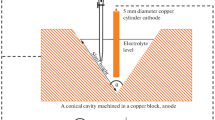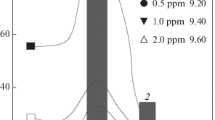Mass transfer from the volume of medium within a crevice and conversely is of considerable importance for crevice corrosion. A device is used based on a system of two horizontal coaxial disks, one of which (specimen with an annular crevice) is stationary, and the second (counter disk) rotates. This makes it possible to control hydrodynamic conditions around the stationary disk surface and evaluate quantitatively the rate of convective-diffusion mass transfer towards its surface. Data are obtained for the distribution of liquid flow rate over the depth of a crevice with a prescribed counter disk rotation frequency. It is shown that with an increase in crevice width the more critical value of cathodic process rate at a surface within a crevice remains constant, in spite of an increase in solution convective restoration intensity within a crevice. Under natural convection condition within the volume of solution oxygen distribution over the depth of a crevice is very uneven, and this may lead to occurrence of differential aeration pairs. With induced convection within solution around the mouth of a crevice, the cathodic process of oxygen renewal penetrates into the depth of a crevice and is distributed more uniformly over the surface within a crevice.







Similar content being viewed by others
References
Takamura Akiro, Corrosion, 23, No. 10, 306–313 (1967).
M. Fromberg, Korrosion, 14, No. 5, 267–269.
E. L. Liening, Material Performance, 22, No. 11, 37–44 (1983).
Yu. S. Ruskol, Titatnium Structural Alloys in Chemical Production [in Russian], Khimiya, Moscow (1989).
D. I. Khasanova, D. Kh. Safin, and A. R. Gilmullina, Korroziya: Mater., Zash., No. 4, 24–27 (2011).
V. S. Pakhomov, Korroziya: Mater., Zash., No. 6, 35–42 (2003).
G. Shlikhting, Boundary Layer Theory [in Russian], Nauka, Moscow (1974).
Yu. A. Buevich, V. N. Mankevich, and V. S. Pakhomov, Dokl. Akad. Nauk SSSR, 289, No,.6, 1402–1407 (1986).
V. S. Pahomov and V. E. Makartsev, Zash. Met., 23, No. 6, 943–948 (1987).
V. S. Pakhomov and R. Videnbek, Inventor’s Cert. USSR No. 1233007, MKI G01N17/00, publ. 05.23.1986.
R. Videnbek, Diss. Cand Tech. Sci., Moscow (186).
V. S. Pakhomov, Korroziya: Mater., Zash., No. 9, 37–48 (2006).
V. G. Levich, Physicochemical Hydrodynamics [in Russian], Fizmatgiz, Moscow (1959).
I. O. Rozenfeld, Corrosion and Protection of Metals [in Russian], Metallurgiya, Moscow (1970).
I. B. Ulanovskii and Yu. M. Korovin, Zash. Met., 11, No. 1, 38–40 (1975).
Author information
Authors and Affiliations
Additional information
Translated from Khimicheskoe i Neftegazovoe Mashinostroenie, No. 5, pp. 36–41, May, 2012.
Rights and permissions
About this article
Cite this article
Pakhomov, V.S., Videnbek, R. Cathodic processes in annular crevices. Chem Petrol Eng 48, 315–323 (2012). https://doi.org/10.1007/s10556-012-9617-0
Published:
Issue Date:
DOI: https://doi.org/10.1007/s10556-012-9617-0




